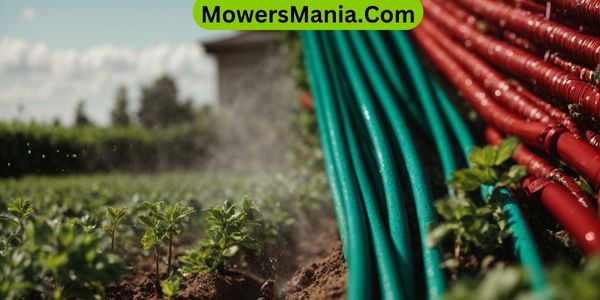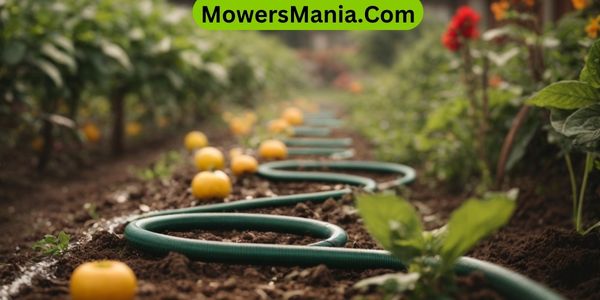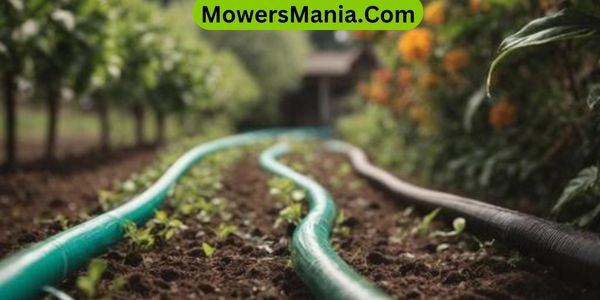Are you debating between using drip irrigation or a soaker hose for your lawn? Wondering which option is the better choice? Look no further!
In this article, we will compare the two methods and help you make an informed decision. From water efficiency to customization and cost-effectiveness, we will delve into all the factors you need to consider.

So, let’s dive in and find out which irrigation method suits your needs best!
Water Efficiency
If you want to maximize water efficiency in your lawn, using a soaker hose will often be the better choice. Soaker hoses are designed to deliver water directly to the roots of your plants, minimizing water waste through evaporation and runoff.
Unlike traditional sprinklers that spray water into the air, soaker hoses release water directly into the soil, ensuring that it goes exactly where it’s needed.
By using a soaker hose, you can significantly reduce water usage compared to other watering methods.
The slow and steady release of water allows it to penetrate deeply into the soil, promoting healthier root growth and reducing the need for frequent watering. This not only helps conserve water but also saves you time and effort in maintaining your lawn.
Another advantage of soaker hoses is their versatility. They can be easily customized to fit any garden layout, whether it’s a small flower bed or a large vegetable patch. You can easily cut and connect multiple hoses to create a precise watering system that targets specific areas of your garden.
In addition to water efficiency, soaker hoses also help prevent weed growth by delivering water directly to your plants’ roots. This eliminates the water supply that weeds need to thrive, reducing the need for manual weeding or the use of chemical herbicides.
Installation and Setup
To properly set up your garden irrigation system, how can you ensure a seamless installation and setup process for either drip irrigation or a soaker hose? Both drip irrigation and soaker hoses require a similar installation process, but there are a few key differences to consider.
First, let’s talk about drip irrigation. To install a drip irrigation system, you’ll need to lay out the main supply line along the desired watering area. Then, attach the drip emitters or micro-sprinklers to the main line at regular intervals.
Make sure to secure the lines with stakes or clips to keep them in place. Finally, connect the main supply line to a water source, such as a faucet or a water timer.
On the other hand, setting up a soaker hose is a bit simpler. Start by laying out the hose along the area you want to water. Secure it with stakes or clips to prevent it from moving. Then, connect the soaker hose to a water source, such as a faucet or a rain barrel.
Regardless of which system you choose, it’s important to check for any leaks or clogs before turning on the water. This will ensure that the water is evenly distributed throughout the garden.
Plant Health and Disease Prevention

Maintaining plant health and preventing diseases is crucial when choosing between drip irrigation and a soaker hose. Both watering methods have their advantages and disadvantages when it comes to plant health and disease prevention.
Drip irrigation is known for its precise and targeted watering system. The water is delivered directly to the plant’s roots, minimizing the risk of leaf wetting.
This reduces the chances of fungal diseases, such as powdery mildew and leaf spot, which thrive in damp conditions. Additionally, drip irrigation conserves water by delivering it efficiently to the plants, preventing overwatering and root rot.
On the other hand, a soaker hose provides a slow and steady release of water along its length. This method promotes deep root growth and helps plants develop stronger root systems. However, the water is spread over a larger area, including the soil surface and foliage.
This increased moisture on the leaves can create a favorable environment for diseases to thrive. To reduce the risk, it’s important to water early in the morning, allowing the foliage to dry quickly.
Customization and Flexibility
When choosing between drip irrigation and a soaker hose, you can customize and adjust the watering system to meet your specific needs. Both options offer flexibility in terms of installation and layout.
With drip irrigation, you have the freedom to create a personalized system that caters to the unique requirements of your garden. You can easily adjust the spacing between emitters to ensure that each plant receives the appropriate amount of water.
Additionally, you can control the flow rate and duration of watering by using different types of emitters or by employing a timer.
Soaker hoses also provide customization options. These hoses are flexible and can be easily bent or curved to fit the shape of your garden. You can cut and connect multiple hoses to reach different areas of your landscape.
By adjusting the water pressure, you can control the amount of water delivered to each plant. Soaker hoses can also be buried under mulch or soil to create a hidden watering system.
In terms of customization, both drip irrigation and soaker hoses offer versatility and adaptability. It’s important to consider the specific needs of your plants and the layout of your garden when making a choice.
Cost-effectiveness

For cost-effectiveness, you can compare the expenses of drip irrigation and a soaker hose. Both options have their own initial costs and ongoing expenses to consider.
Drip irrigation systems typically require a higher upfront investment compared to soaker hoses. The cost of purchasing the necessary equipment, such as emitters, tubing, and filters, can add up.
However, drip irrigation systems are designed to be more efficient in water usage, which can result in long-term savings on your water bills.
On the other hand, soaker hoses are generally more affordable upfront. They consist of porous hoses that allow water to seep out slowly and directly into the soil.
While they may not be as precise as drip irrigation systems, they’re still effective in delivering water to your plants.
However, it’s worth noting that soaker hoses can be less durable and may need to be replaced more frequently, which can increase the overall cost over time.
Ultimately, the choice between drip irrigation and a soaker hose depends on your budget and long-term goals.
Frequently Asked Questions [FAQs]
How Long Does It Take to Set up a Drip Irrigation System or a Soaker Hose System?
To set up a drip irrigation system or a soaker hose system, it depends on various factors like the size of your garden and your experience. Generally, it takes a few hours to a day to complete the installation.
Can a Drip Irrigation System or a Soaker Hose Be Used for Container Gardening?
Yes, both a drip irrigation system and a soaker hose can be used for container gardening. They provide a convenient way to deliver water directly to the plants’ roots, promoting healthy growth.
Are There Any Specific Maintenance Requirements for Drip Irrigation Systems or Soaker Hoses?
For both drip irrigation systems and soaker hoses, there are some maintenance requirements to keep in mind. Regularly check for leaks and clogs, adjust water flow as needed, and ensure proper installation and coverage for optimal performance.
How Often Should the Water Supply Be Turned on for a Drip Irrigation System or a Soaker Hose System?
When using a drip irrigation system or a soaker hose system, you should consider how often to turn on the water supply. This will depend on factors like plant needs and weather conditions.
Can a Drip Irrigation System or a Soaker Hose Be Used in Areas With High Water Pressure?
Yes, you can use a drip irrigation system or a soaker hose in areas with high water pressure. However, it is recommended to use a pressure regulator to ensure the water flow is controlled.
Conclusion
In conclusion, when choosing between drip irrigation and a soaker hose, it’s important to consider factors such as:
- Water efficiency
- Installation and setup
- Plant health and disease prevention
- Customization and flexibility
- Cost-effectiveness
Both methods have their advantages and disadvantages, so it ultimately comes down to personal preference and specific gardening needs.
Whichever option you choose, ensuring proper watering techniques will help promote healthier plants and a more sustainable garden.



